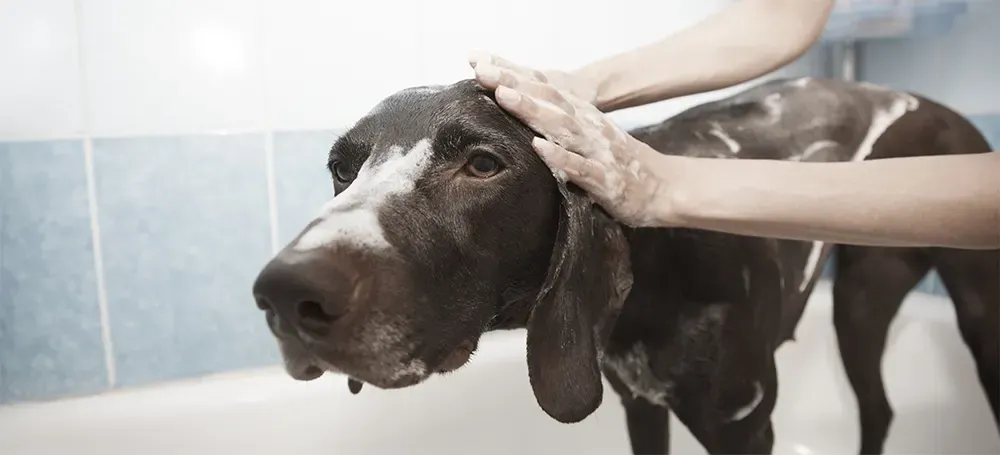Tips to Prepare your Puppy for Handling

During your puppy's life, there will be many times when it is necessary for you or someone outside your family to handle him physically in ways that may seem strange to him. At home, during quiet times, you can help your puppy become more comfortable with being handled in these different ways; and the earlier you start, the more relaxed he will be when these situations actually occur.
Veterinarian Examination
Gently pat your puppy on different areas of his body while he is in a relaxed state. Mimic how the vet will examine your puppy. Touch around his eyes and ears, gently hold his feet and toes, lift his lips and touch his teeth, hold your hand against his chest, gently move his legs, etc. Take your time with this kind of touch and do it often so that it becomes an agreeable experience for your pup both at home and at the vet. Teach him to sit and lie down while you are examining him. It will make your vet's job much easier if your pup is not squirming during his examinations.
Take your puppy to the vet clinic at times other than his appointments for vaccinations and checkups (you may want to call your vet's office first to make sure this is OK and find out when they are less busy). Swing by with him and put him on the scale, then ask the staff if they would like to pet him and/or give him a treat. This way, he will start to associate visiting the vet as a more positive experience.
Groomer Visits
Start early with short sessions at home, using a brush well-suited to your puppy's type of coat and always brushing in the direction of the hair growth, working in sections. Be consistent, make the experience pleasurable and go slowly. Keep some treats in your non-brush hand to distract your puppy. Stop brushing when he seems more concerned with the brush than the treats.
Get your puppy used to the feeling of water by placing him in a bathtub or shower with a towel in it so he doesn't slip. After he seems comfortable, gently turn the water on and dab a little on his back with a washcloth. By taking it slowly, you will help him enjoy the grooming experience. Be careful not to use shampoos that may strip the natural oils of his coat.
Tooth Brushing
Proceed slowly, over the course of days or even weeks. First, apply a little doggy toothpaste on your puppy's toothbrush and place it in his mouth. If he doesn't like the taste, try another brand. Next, apply toothpaste on your fingers and explore the inside of his mouth, without actually brushing. When your puppy is comfortable with the above, try lightly brushing his rear teeth with his brush, moving forward. Try to use a circular motion, using care to massage but not scour his gums. Your puppy may clamp down on the toothbrush, but resist trying to pry his mouth open. Instead, relax your hand. Eventually your puppy will have to change his bite on the toothbrush. With experience, you can discern a rhythm in your puppy's oral motions as he opens, licks the brush and clamps down again. When you do, start brushing a few teeth at a time until you are able to apply the paste to all of his teeth the enzymes in the toothpaste will do a lot of the scrubbing for you.
Nail Clipping
To prepare your puppy for nail clipping, first let your puppy get used to the smell and sound of pet nail clippers and to having his feet held; gently massage between his toes and nails. To start, just touch the clippers to your puppy's nail to see if he is comfortable with them. This may be enough for his first session.
Following the above steps, trim the smallest possible amount of nail, praising your puppy's calmness. You may need to "distract" him by holding a treat tightly in your hand while you clip; reward him with the treat when you are done. For some puppies, asking a friend or family member to hold or distract him may also be beneficial. If you opt to continue with do-it-yourself nail clipping, always make very small clips so as not to cut the nail's "quick" (the area where the nail's blood supply begins), which is difficult to see on dark nails. If you feel uncomfortable or unsure at all, stop and take your dog to a professional.
Don't try to do all these activities in one session or by yourself. If your puppy is uncomfortable, just do one task at a time or ask for help from a trusted professional. Be sure to maintain a light and playful attitude; overly reassuring your puppy during the process may make him think there is a reason for him to become anxious. Respect any growls or defensive body language signs from your puppy, and always start with a call to your veterinarian if you suspect your dog is having an abnormal reaction to a situation that should not be causing him pain. Professional dog training will also help you establish a bond with your puppy as he grows in his trust of you and your relationship.
Please note that every puppy has different needs when it comes to physical handling; when in doubt, ask your veterinarian, groomer or trainer for advice or assistance
Recent Articles
- Easter Holidays - Keeping our dogs safe around food
- Horticultural Horrors for Hounds
- Understanding Dog Body Language
- Heatstroke in dogs - know the signs and what to do
- Preventing Separation Anxiety When Returning To Work
- Separation Anxiety
- Managing your time at home with your dog
- Top 10 Indoor Games for your Dog
- Working from home with your dog
- COVID-19 Social Distancing and Self Isolation
